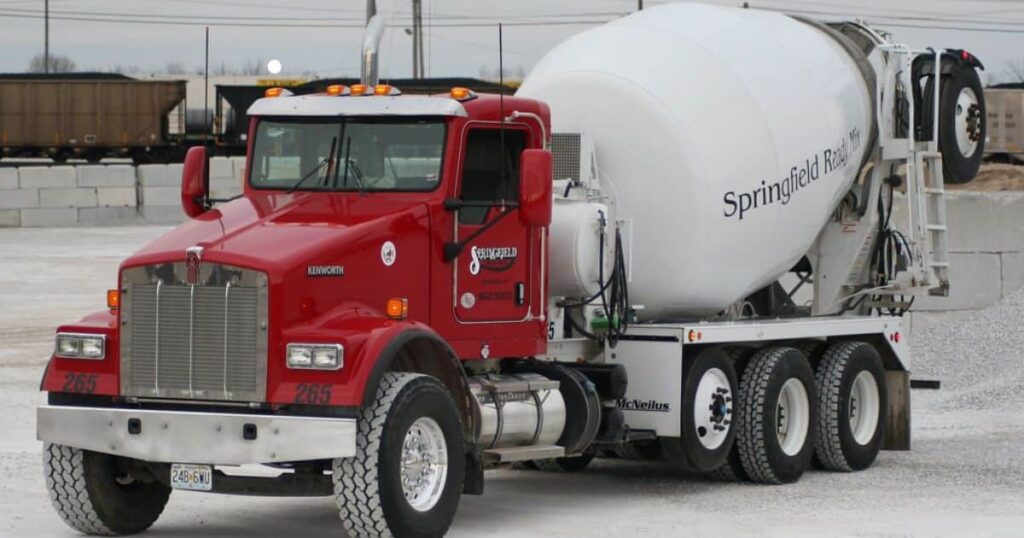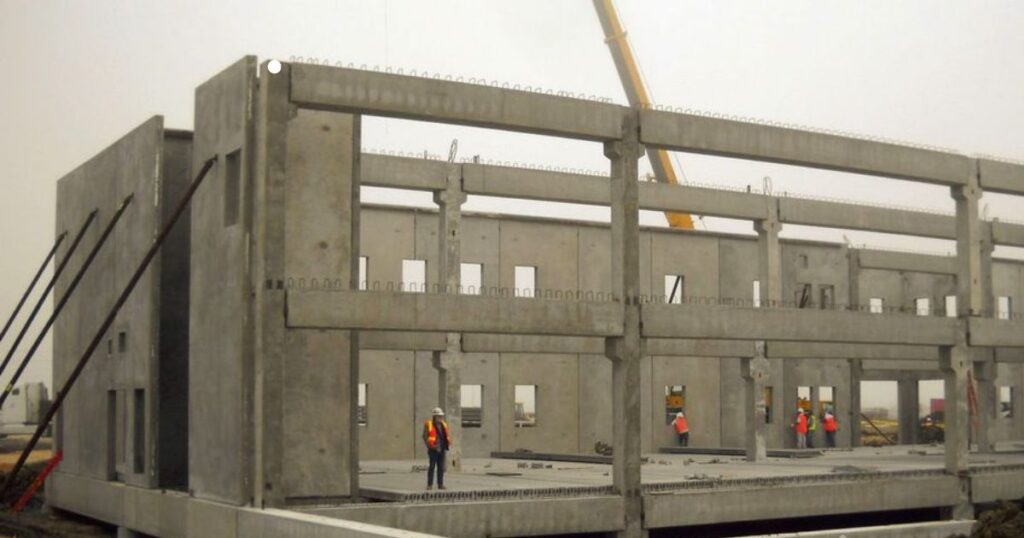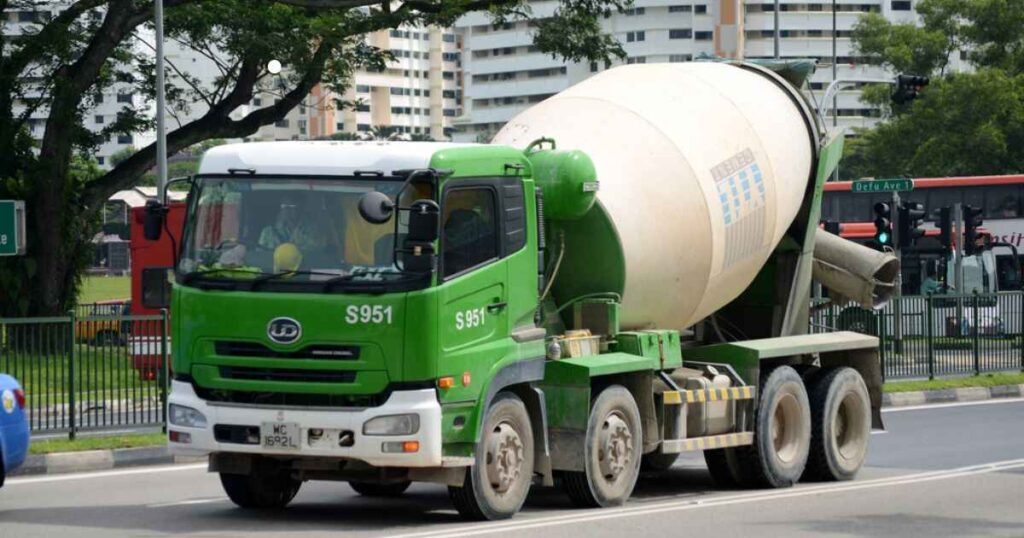Concrete is the backbone of modern construction, used to create everything from residential foundations to towering skyscrapers.
But have you ever wondered about the massive logistics involved in transporting all that concrete to a job site? Specifically, how much can one concrete truck actually hold?
In this article, we’ll take an in depth look at concrete truck capacities, exploring industry standards, influencing factors, and calculation methods.
Whether you’re a contractor gearing up for a new project or just someone curious about the construction world, this guide will provide valuable insights.
Definition of a Cubic Yard of Concrete
Before we dive into truck capacities, let’s establish what a cubic yard of concrete actually is. A cubic yard is a standard volumetric measurement equal to a cube with each side measuring 3 feet (or 36 inches).
To visualize it, imagine a box:
- Length: 3 feet
- Width: 3 feet
- Height: 3 feet
That’s one cubic yard of concrete. It may not seem like much, but keep in mind that concrete is extremely dense. A single cubic yard can weigh over 4,000 pounds.
How much does a cubic yard of concrete weigh?

The weight of a cubic yard of concrete can vary slightly depending on the specific mix design and water ratio used.
A good rule of thumb is:
One cubic yard of conventional concrete weighs approximately 4,050 lbs (1,835 kg).
Some key factors that influence concrete weight per cubic yard include:
- Cement content: Higher cement ratios result in denser, heavier concrete.
- Aggregate type: Heavier aggregates like steel slag increase the weight.
- Water ratio: More water leads to a slightly higher weight per cubic yard.
For precise calculations on a job, you’ll want to consult the approved mix design specifications. But in general, you can expect one cubic yard of standard concrete to weigh around 2 tons.
How Many Cubic Yards of Concrete Can Fit in a Truck?
Now to the main question – what is the typical capacity for a concrete truck? Most concrete mixer trucks have a barrel capacity ranging from 8 to 10 cubic yards.
While this is the standard range, it’s important to note that actual loadable capacity can be lower due to various factors we’ll cover later.
For very large construction projects requiring immense volumes of concrete, some trucking companies utilize non-standard rigs with enhanced capacities up to 12 cubic yards per truck.
Interesting Fact: Who Makes Infiniti Cars
Capacities of Common Concrete Truck Sizes
To give you a better sense of real-world truck dimensions, let’s look at some common sizes and their corresponding rated cubic yard capacities:
| Truck Drum Size | Rated Capacity |
| 6 Cubic Yards | 6 Cubic Yards |
| 8 Cubic Yards | 8 Cubic Yards |
| 10 Cubic Yards | 10 Cubic Yards |
| 12 Cubic Yards | 12 Cubic Yards |
It’s crucial to understand that these rated capacities represent maximum volumes under ideal conditions. Factors like buildup, truck weight limits, and travel distances can all lead to reduced real-world capacities compared to what’s listed on the manufacturer specs.
What is Concrete Buildup?

One issue that concrete truck operators have to deal with is buildup – the accumulation of semi-dried concrete layers on the interior drum walls.
As the truck makes deliveries throughout the day, thin layers of concrete begin to build up and harden, decreasing the usable drum volume.
Experienced drivers try to minimize buildup through techniques like:
- Adding drum spray to increase concrete flowability
- Adjusting truck rpm to keep the concrete viscous
- Loading concrete in a specific sequence to reduce excess splashing
However, some degree of buildup is inevitable over an 8-hour work period. This buildup can reduce the truck’s effective capacity by 0.5 – 1 cubic yard compared to the rated volume when fully cleaned.
Types of Concrete Trucks
While the classic rear-discharge concrete truck is the most ubiquitous, there are several other designs that construction crews may encounter:
Rear Discharge Truck
The standard and most common concrete truck, featuring a revolving drum mixer and a chute at the rear for discharging concrete at the job site. Rear discharge trucks typically have capacities from 8-12 cubic yards.
Front Discharge Truck
Also known as a “front discharger” or “transfer truck“, these trucks offload concrete over the front cab area instead of the rear. This allows for tighter workspaces and faster discharge cycles. Front discharge capacities tend to be 6-8 cubic yards.
Volumetric Mixer Truck
Rather than a revolving drum, volumetric mixers keep their dry and wet concrete ingredients separate until they reach the job site.
This allows for on-site mixing of precisely metered quantities ideal for smaller jobs or remote areas. Capacities max out around 12 cubic yards.
While the specific model may vary, understanding these different truck types and their respective capacities is useful for construction planning.
Factors Affecting Concrete Truck Carrying Capacity
Even with rated cubic yard capacities from the manufacturer, there are several variables that influence how much concrete a particular truck can safely transport:
Truck Size

Bigger trucks can simply hold more concrete by virtue of having larger drum sizes. An 8 cubic yard truck will always be more limited than a 10 cubic yard option.
Maximum Weight Limits
While capacities are listed volumetrically in cubic yards, concrete’s high density means weight is also a critical factor. All road-worthy vehicles have maximum gross weight ratings they cannot exceed.
For example, a standard 10-wheeler concrete truck may be rated for 10 cubic yards of capacity. But if you actually loaded a full 10 yards of conventional concrete (over 40,000 lbs!), it would likely exceed that truck’s maximum allowed weight for highway travel.
Most concrete trucks will top out around 8 cubic yards of conventional concrete to comply with weight restrictions. Hauling the denser mixes may require even lower volumes.
Travel Distance
Longer travel distances from the batch plant to the job site increase the potential for excessive buildup inside the drum, reducing remaining capacity. Concrete companies have to account for this lost capacity on longer jobs.
How Many Cubic Yards Does a Standard Concrete Truck Hold?
Given all the factors we’ve covered so far, what is the realistic, average capacity you can expect from a standard concrete truck?
For a typical 10 cubic yard truck, the safe loadable capacity tends to be:
8 cubic yards of conventional concrete mix
This accounts for weight restrictions on public roads as well as the buildup that occurs during travel and discharge cycles throughout a work day.
Larger 12 cubic yard trucks may be able to max out closer to 10 yards, while smaller 8 yard trucks usually shouldn’t exceed 6-7 yards of concrete to remain street-legal.
Of course, these are just general guidelines. For any specific job, you’ll want to consult the concrete company to get their professional opinion on truck sizes and concrete volumes.
Calculating Cubic Yards of Concrete Needed

Now that we understand concrete truck capacities, let’s cover how to calculate approximately how many cubic yards your particular job will require.
For estimating concrete needs, you’ll want to first find the total volume in cubic feet by multiplying the length x width x height of the area being poured. For example, a 20 ft x 10 ft slab with 6 inch (0.5 ft) thickness would be:
Total Cubic Feet = 20 x 10 x 0.5 = 100 cubic feet
Then, convert that cubic footage into cubic yards by dividing by 27 (the number of cubic feet in one cubic yard):
100 cubic feet / 27 = 3.7 cubic yards
So for a slab with those dimensions, you’d need around 4 cubic yards of concrete. Always round up when calculating concrete needs to have enough for the job.
For projects involving multiple areas like footers, stems, and a slab, calculate each section’s cubic yardage individually and sum the totals.
Pro Tip: Concrete calculators can make these volumetric estimates much easier! Most concrete companies provide free online calculators where you just input the length, width, and depth dimensions.
Being Prepared When the Concrete Truck Arrives
Once you’ve calculated your concrete needs and scheduled the pour, it’s crucial to have everything ready to go when that truck rolls up to the job site. Concrete is a perishable material that becomes unworkable within 1-2 hours after mixing and loading.
Here are some tips for being prepared:
- Clear the workspace: Ensure there is a clear path for the truck to back up and discharge the concrete as close as possible to the pour location. Remove any obstructions.
- Have tools/equipment ready: Have wheelbarrows, shovels, rakes, screeds and anything else required to spread and work with the wet concrete staged and ready.
- Assemble your crew: Make sure you have enough manpower on site to handle the pace of discharge from the truck. The last thing you want is expensive concrete just sitting and setting up.
- Check the forms: Inspect all formwork, reinforcement, and anything receiving the concrete one last time before the pour.
- Wet down area: Lightly dampening the sub-grade or any adjacent concrete can prevent moisture wicking away from the new pour.
Being prepared allows the concrete discharge to happen smoothly and maximizes the valuable workable time before the mix begins setting up.
How is Concrete Charged and Invoiced?
In most cases, concrete is charged by the cubic yard with minimum loadable amounts set by the provider. Even if you only need 5 cubic yards for example, most companies will have a minimum 6 or 7 yard chargeable truck load.
There are also cases where you may be charged for the entire contents of the concrete truck, even if you don’t use it all. This prevents the hassle of trying to calculate partial loadings.
Top tip: Always confirm billing policies like minimums and full truck charges with your concrete provider before scheduling a pour to avoid surprises.
Additionally, many companies charge “truck delay” fees if they have to wait an excessive amount of time on the job site to discharge their concrete. These fees can quickly add up, so being prepared is critical.
When is Support Reinforcement Needed?
Depending on the application, residential concrete slabs, footers, and other minor pours may not require any additional reinforcement like rebar or wire mesh. But for structural components, reinforcement is critical.
Some common scenarios where you’ll likely need reinforcing include:
- Structural footings and foundations
- Concrete driveways and floors
- Concrete walls and columns
- Suspended concrete decks or platforms
Always check local building codes and structural engineer specifications, as reinforcement requirements can vary based on design criteria like load conditions, concrete PSI strength, and dimensions.
What Details Do Concrete Companies Need?
To accurately quote and schedule a pour, most concrete companies will need some key information from you about the job site and timeline.
This typically includes:
- Project address/location: They need to know where to dispatch the truck(s).
- Pour dimensions: The volumetric dimensions calculated as discussed previously.
- Slump requirements: The desired concrete slump or flowability based on the application.
- PSI strength: Concrete is batched to achieve different strength classes (3000 PSI, 4000 PSI, etc).
- Timeline needs: Your target pour date/time and rate of concrete placement required.
- Soil conditions: Poor soil conditions may require a sturdier concrete mix.
- Curing instructions: Some jobs have specific curing compound or waterproof covering requirements.
The more details you can provide upfront, the smoother the quoting and logistics process will be for selecting the right concrete company.
How to Choose a Reputable Concrete Company
With the complexities involved in batching, transporting and properly placing concrete, it’s extremely important to hire an experienced, reputable concrete provider.
A few key factors to consider include:
- Experience and Specializations: Look for companies with extensive experience, especially in the type of construction you are doing. Some may specialize in residential, commercial, industrial, etc.
- Fleet Capabilities: Ensure they have the appropriate truck sizes and volumes to handle your pour requirements efficiently. No one wants to be waiting on multiple small truck loads.
- Quality Control: Inquire about their batching processes, certifications, and quality testing procedures. Concrete strength and consistency is critical.
- Scheduling and Reliability: Choose a company that values on-time delivery and has robust logistics capabilities to deploy trucks with precision scheduling.
- Pricing: Get quotes from multiple companies and look at factors beyond just cheapest price – overhead fees, delay charges, etc. Concrete is one area where you generally get what you pay for.
- Reviews and Reputation: Check online reviews, talk to other contractors, and ensure they have a solid reputation for standing behind their work.
By evaluating concrete companies across these areas, you can confidently select a partner that will execute a quality, stress-free pour for your project.
Recommended Post: What Is A PCM On A Car? The Ultimate Guide For American Drivers
Frequently Ask Question
How many m3 of concrete in a truck?
The volume of concrete in a truck typically ranges from 6 to 10 cubic meters, depending on the truck size and type.
How much is 10 cubic yards of concrete?
10 cubic yards of concrete typically costs between $1,200 to $1,800, including delivery fees and any additional charges for additives or special mixes.
How many tons are in a concrete truck?
A standard concrete truck can carry approximately 8 to 10 cubic yards of concrete, which translates to roughly 18 to 23 tons, depending on the density of the concrete mix.
How much concrete is in one load?
The amount of concrete in one load varies depending on the truck’s capacity, but it typically ranges from 8 to 10 cubic yards.
How heavy is a 10 yard concrete truck?
A 10-yard concrete truck typically weighs around 66,000 pounds (33 tons) when fully loaded with concrete, water, and other materials.
In Conclusion
While concrete truck capacities are measured in simple cubic yards, there’s quite a bit of logistics and physics involved in determining accurate real-world volumes.
By understanding factors like truck sizes, weight limits, travel distances and more, you can ensure your construction projects receive the right amount of concrete when needed.
Whether you’re a seasoned contractor or DIY homeowner taking on a slab pour, carefully calculating cubic yard needs and making preparations for the concrete truck’s arrival will go a long way toward a successful pour.
With this guide’s insights into capacities and best practices, you’re now well-equipped to effectively manage concrete deliveries on your next job!







